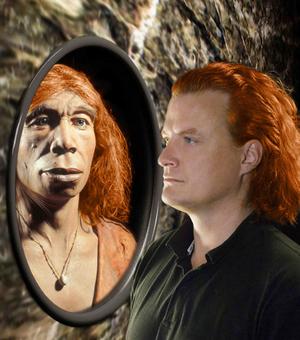There is a little bit of Neanderthal in many of us
Big party at Science journal today, with the publication of a comprehensive draft Neanderthal genome. (Free access, nice going Science). Actually, it is a partially assembled draft of 60% of the total genome, but 60% of the genome from a human that was last seen on Earth 28,000 years ago is quite an achievement. The DNA was extracted from three bone fragments found in a cave in Croatia. The bones came from different individuals, so it is a composite rather than the draft genome of a single person. Also, the coverage — number of times each base was sequenced on average — is only 1.3, which is quite low,which means that in all probability there are still quite a few sequencing errors. Sequencing errors get weeded out as more overlapping regions get sequenced: the spurious sequencing errors get diluted with every new sequencing run. Still, we can learn many things about ourselves and our recently-extinct human companions even from a partial, fragmented and somewhat still-erroneous sequence.
![]()
Until now we had only three good, full copies of Neanderthal mitochondrial DNA. Mitochondrial DNA codes for a relatively small number of genes, and is inherited through the mother. There are regions on the DNA that are more variable, which helped us map the genetic distance between modern humans and Neanderthals. Actually, I did that in my bioinformatics course this year. The conclusion reached by the researchers who did that, as well as by my students was that modern humans are much closer to each other than to Neanderthals, and that the genetic distance is large enough to make humans and Neanderthals two different species.
But the genomic DNA reveals that between 1-4% of modern human DNA is close enough to equivalent segments from Neanderthal DNA to claim a gene flow and hence interbreeding. Second, Neanderthals are closer to European and Asian humans than they are to those from sub-Saharan Africa. Actually, modern humans from sub-Saharan Africa do not have the Neanderthal DNA markers. This fits well with the current hypothesis on the origins of Neanderthals: they were the descendants of the first Out of Africa migration, some 500,000 years ago. They lived in Europe and Asia, while the ancestors of modern humans lived in Africa. The second out of Africa migration happened about 100,000 years ago, which is when modern humans first encountered Neanderthals and, as shown now by this study, have interbred with them.
On the spelling of Neandert(h)al: you many have noticed that the spelling in the Science paper, and in many other places is “Neandertal”, whereas others spell it as “Neanderthal”. (My Firefox spellchecker actually does not like the h-less version.) Talkorigins.org explains why that is.
Now, if you will kindly excuse me, I have some slides and a student lab to revise for next year.
Green, R., Krause, J., Briggs, A., Maricic, T., Stenzel, U., Kircher, M., Patterson, N., Li, H., Zhai, W., Fritz, M., Hansen, N., Durand, E., Malaspinas, A., Jensen, J., Marques-Bonet, T., Alkan, C., Prufer, K., Meyer, M., Burbano, H., Good, J., Schultz, R., Aximu-Petri, A., Butthof, A., Hober, B., Hoffner, B., Siegemund, M., Weihmann, A., Nusbaum, C., Lander, E., Russ, C., Novod, N., Affourtit, J., Egholm, M., Verna, C., Rudan, P., Brajkovic, D., Kucan, Z., Gusic, I., Doronichev, V., Golovanova, L., Lalueza-Fox, C., de la Rasilla, M., Fortea, J., Rosas, A., Schmitz, R., Johnson, P., Eichler, E., Falush, D., Birney, E., Mullikin, J., Slatkin, M., Nielsen, R., Kelso, J., Lachmann, M., Reich, D., & Paabo, S. (2010). A Draft Sequence of the Neandertal Genome Science, 328 (5979), 710-722 DOI: 10.1126/science.1188021




















who’s in the pic?
Some of us have *more* neandertals than others…
😉